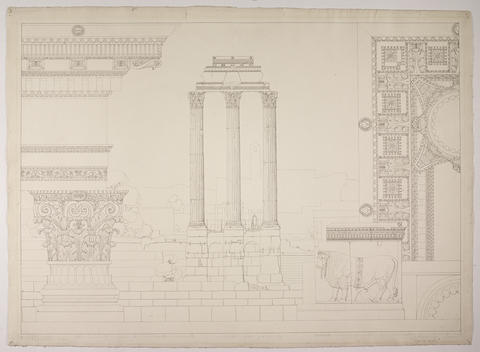License:
 This image is provided under a Creative Commons BY-NC-SA License. You can download this version for private study or non-commercial use. Our terms, conditions and copyright policy (PDF) contains further information about acceptable usage. If you are seeking permission to publish, please contact us ›
This image is provided under a Creative Commons BY-NC-SA License. You can download this version for private study or non-commercial use. Our terms, conditions and copyright policy (PDF) contains further information about acceptable usage. If you are seeking permission to publish, please contact us ›
Please click here if you would like to request a larger, high-resolution version ›
Key Information
Reference code
Title
Date(s)
- 1928-1930 (Creation)
Level of description
Item
Extent
2 of 2
Content and Structure
Scope and content
Decorative details.
Appraisal, destruction and scheduling
Accruals
System of arrangement
General Information
Name of creator
Biographical history
James Andrew Carrick was born on 22 April 1911, the son of James Carrick, architect, of Ayr and his wife Susan Cunningham. He attended Ayr Academy. He commenced his studies at the Glasgow School of Architecture in 1928 and served his apprenticeship with James Miller. In 1930 he spent a month touring England to study ecclesiastical architecture, and in the following year he won the Alexander Thomson travelling studentship in 1931, which he used for a three-month study tour of Rome and Northern Italy two years later; and in 1932 he was runner-up for the Grissell Medal. He obtained his diploma and passed the professional practice exam in summer 1933, enabling him to be admitted ARIBA on 4 December that year, his proposers being Andrew Graham Henderson, John Keppie and James Archibald Morris, an old friend of his father's. By that time he had been assisting in his father's office for over a year. In 1934 he was taken into partnership, the firm's name changing to J & J A Carrick, and in the same year he spent a month studying Greek buildings in Sicily and Southern Italy as Bourdon Memorial Student. The elder Carrick was an excellent Arts and Crafts architect, mainly in an English Tudor-Jacobean idiom close in style to Miller's work. In the younger Carrick's hands the direction of the practice quickly changed, although traditional Arts and Crafts could still be provided according to the tastes of the client. The son was a significant modernist, as can be seen at Gourock and Rothesay Pavilions and to a lesser degree at Ayr Ice Rink, but his career was curtailed by the Second World War. The elder Carrick died in 1940. The younger Carrick served as an officer with the Royal Artillery during the Second World War and resumed practice after the war. He was elected FRIBA in 1953, proposed by Andrew Graham Henderson, William James Smith and William McCrea, at which time he was still practising from Wellington Chambers. He served as President of the Glasgow Institute of Architects from 1958-60 and as President of the RIAS from 1969-71. He retired in 1981 enabling him to spend more time on his leisure pursuits, fishing, golf and gardening. He had a position with the River Doon Fisheries Board, was a keen Rotarian and served for a spell as President of the Ayr Rotary Club as well as being Captain of the Turnberry Golf Club in 1985 and 1986. The practice continued operating in central and southern Scotland until 1982 when it merged with Cowie Torry and Partners and became Carrick Cowie and Torry. The new partnership took over the practice of T K Irving and Partners of Stranraer in 1985 and in 1999 changed its name to Carricks, James Andrew Carrick having died on 23 November 1989 in Ayr County Hospital. He was survived by his wife, Christiana Margaret Waddell, and his son and daughter. He was described by his obituarist as a 'kind man and a good practitioner'.
Archival history
Custodial history
Estate of Hugh Ferguson, 01.02.05.
Physical Description and Conditions of Use
Conditions governing access
Conditions governing reproduction
Language of material
Script of material
Language and script notes
Physical Description
pen and ink on paper
Dimensions: 570 x 780 mm
Finding aids
Related Material
Existence and location of originals
Existence and location of copies
Related materials
Notes area
Alternative identifier(s)
Keywords/Tags
Subjects
Place access points
People and Organisations
Genre access points
Status
Level of detail
Processing information
Language(s)
Script(s)
Sources
Digitised item metadata
Filename
NMC_0812B.jpg
Latitude
Longitude
Media type
Image
Mime-type
image/jpeg


